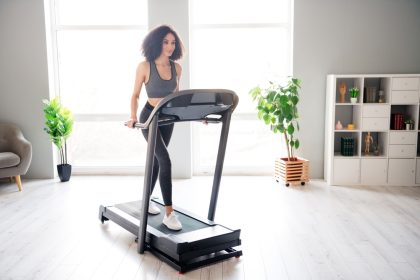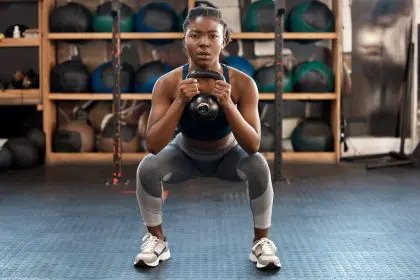Picture this – you’re at the park and see someone walking backwards on the path, looking completely focused and intentional about it. Your first thought might be that they’re lost or confused, but they’re actually participating in one of the hottest fitness trends that’s quietly taking over gyms, physical therapy clinics, and walking trails everywhere.
Walking backwards, or “retro walking” as fitness enthusiasts call it, sounds like the kind of gimmicky exercise trend that’ll disappear faster than your motivation to go to the gym. But this seemingly simple activity is backed by serious science and delivering results that are making even skeptical trainers and physical therapists take notice.
The beauty of backwards walking lies in its deceptive simplicity. It looks ridiculous, feels awkward at first, and challenges your body in ways that forward walking simply cannot match. What started as a rehabilitation technique for injured athletes has evolved into a legitimate fitness strategy that’s helping regular people achieve better balance, stronger muscles, and improved cardiovascular health.
Your brain gets a workout it never saw coming
Walking backwards forces your brain to work in completely different ways than normal forward movement. Every step requires intense concentration, spatial awareness, and coordination that forward walking takes for granted. It’s like giving your brain a puzzle to solve with every single step.
This cognitive challenge creates what neuroscientists call “neuroplasticity” – essentially rewiring your brain to develop new neural pathways and improve overall brain function. The constant mental engagement required for safe backwards movement strengthens the connections between your brain and your muscles in ways that routine forward walking cannot achieve.
The balance and coordination improvements are almost immediate. People who struggle with stability, whether due to age, injury, or just general clumsiness, often notice significant improvements in their overall balance after just a few weeks of regular backwards walking practice.
The mental focus required also creates a form of moving meditation. When you’re walking backwards, you can’t let your mind wander to your to-do list or work stress because you need complete attention to avoid obstacles and maintain proper form. This forced mindfulness provides mental health benefits that go beyond the physical exercise.
Your muscles get confused in the best possible way
Forward walking uses the same muscle groups in the same patterns every single time. Your body becomes incredibly efficient at this movement, which is great for daily function but not so great for building strength or burning calories. Backwards walking completely disrupts these patterns and forces muscles to work in unfamiliar ways.
The primary muscles that propel you forward during normal walking – your calves and the front of your thighs – become stabilizers during backwards walking, while muscles that normally just provide support suddenly become the primary movers. This role reversal creates strength gains in areas that forward walking barely touches.
Your glutes, which often become lazy during forward walking, are forced to engage much more actively during backwards movement. This increased glute activation helps counter the effects of sitting all day and can improve posture, reduce back pain, and create better overall hip stability.
Even your core muscles work differently during backwards walking. Instead of just providing stability, your abdominal and back muscles have to work dynamically to help control your movement and maintain balance. It’s like getting a core workout while doing cardio, without even thinking about it.
Cardio gets an efficiency upgrade
One of the most surprising benefits of backwards walking is how much more intense it is cardiovascularly compared to forward walking at the same speed. Walking backwards at a moderate pace can elevate your heart rate to levels comparable to jogging forward, but without the joint impact that makes running problematic for many people.
This increased intensity comes from the extra effort required to coordinate unfamiliar movement patterns, maintain balance, and engage muscles that aren’t used to being primary movers. Your body burns significantly more calories during backwards walking because it’s working much harder to accomplish the same basic task of locomotion.
The efficiency gains make backwards walking particularly appealing for people who want cardiovascular benefits but have limited time for exercise. You can get a more intense workout in less time, making it easier to fit effective exercise into busy schedules.
The low-impact nature also makes it accessible to people who can’t participate in high-intensity activities due to joint problems, injuries, or age-related limitations. You get the cardiovascular benefits of more intense exercise without the stress on your knees, ankles, and hips that comes with running or jumping activities.
Joint health improves in unexpected ways
Walking backwards places different stresses on your joints than forward walking, and these different stress patterns can actually be therapeutic for common joint problems. The altered biomechanics can help address muscle imbalances and movement patterns that contribute to pain and dysfunction.
For people with knee problems, backwards walking often feels more comfortable than forward walking because it changes how forces are distributed across the knee joint. The quadriceps muscles work more intensively during backwards movement, which can help strengthen the muscles that support and stabilize the knee.
Ankle mobility and strength improve significantly with backwards walking practice. The different foot strike patterns and weight distribution requirements challenge your ankles in ways that can improve their flexibility and stability, reducing the risk of sprains and other injuries.
Hip flexibility and strength also benefit from the altered movement patterns. Backwards walking requires greater hip extension and different muscle activation patterns that can help counter the effects of prolonged sitting and improve overall hip function.
Balance and fall prevention get serious attention
One of the most valuable applications of backwards walking is for improving balance and reducing fall risk, particularly in older adults. The constant balance challenges inherent in backwards movement train your body’s proprioceptive system – essentially your internal GPS that tells you where your body is in space.
This proprioceptive training transfers to better balance in daily activities. People who practice backwards walking regularly often report feeling more stable when walking on uneven surfaces, climbing stairs, or navigating crowded spaces. The improved spatial awareness and reactive balance responses can significantly reduce fall risk.
The confidence gained from mastering backwards walking also contributes to better overall mobility. When you know you can handle the challenge of walking backwards safely, normal forward walking feels much more manageable and less intimidating.
Physical therapists are increasingly incorporating backwards walking into rehabilitation programs for patients recovering from injuries or dealing with balance disorders because the benefits are so pronounced and measurable.
Getting started safely without looking ridiculous
The biggest barriers to trying backwards walking are safety concerns and feeling self-conscious about looking silly. Both are legitimate concerns, but they’re easily addressed with proper precautions and gradual progression.
Start indoors on a clear, straight path where you can familiarize yourself with the movement without worrying about obstacles or other people. Hold onto a wall or railing initially if needed for security while you develop confidence and coordination.
Begin with very short distances and slow speeds. Even a few steps backwards can be challenging initially, so don’t try to cover long distances right away. Focus on maintaining good posture and smooth, controlled movements rather than speed or distance.
Once you’re comfortable indoors, move to safe outdoor locations like empty parking lots, quiet walking paths, or tracks where you can practice without worrying about traffic or unpredictable obstacles. Always walk backwards in areas you’ve already surveyed walking forward so you know the terrain.
Advanced techniques for serious results
Once basic backwards walking becomes comfortable, there are numerous ways to increase the challenge and maximize the benefits. These progressions can turn a simple backwards walk into a comprehensive workout that targets multiple fitness goals simultaneously.
Incline backwards walking adds significant intensity and muscle activation. Walking backwards up gentle slopes forces your muscles to work even harder and provides greater cardiovascular challenge. Start with very slight inclines and progress gradually as your strength and coordination improve.
Adding arm movements or light weights can increase the complexity and caloric burn of backwards walking. Simple arm swings or carrying light dumbbells engages your upper body and core while maintaining the balance and coordination challenges of the backwards movement.
Interval training with backwards walking can maximize cardiovascular benefits. Alternating periods of faster backwards walking with slower recovery periods creates an efficient and effective cardio workout that’s much more interesting than traditional forward walking routines.
Why this trend has staying power
Unlike many fitness fads that rely on gimmicks or extreme approaches, backwards walking addresses real physiological needs and provides measurable benefits that keep people coming back. The improvements in balance, strength, and cardiovascular fitness are significant enough to justify the initial awkwardness and learning curve.
The accessibility factor also contributes to its staying power. Backwards walking doesn’t require special equipment, gym memberships, or perfect weather conditions. It’s free, available anywhere you have safe walking space, and can be modified for virtually any fitness level or physical limitation.
Perhaps most importantly, backwards walking provides variety and mental engagement that makes exercise more interesting and sustainable. The cognitive challenge and coordination requirements keep your mind occupied in ways that make the time pass quickly and the activity feel less like traditional exercise drudgery.
As more people discover the benefits and overcome the initial hesitation about looking silly, backwards walking is likely to become as common and accepted as other exercise activities that once seemed unusual or trendy but proved their worth over time.















